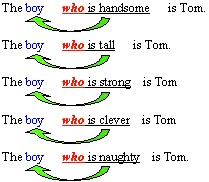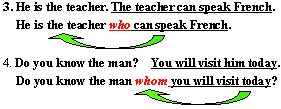初三英语教案推荐
Lesson 65教学设计方案二
Properties: Computer, Projector, PPT document provided.
Teaching Objectives:
1. Understand the dialogue.
2. Learn the grammar: The Attributive Clause.
Language focus: steal - stole - stolen, shoot - shot - shot, hands up
Teaching Procedures:
I.Leading in
Say: We often can’t find our things when need them. When you have something lost, what you will speak?
•I can’t find it.
•I often lose pens.
•I don’t know if I put them here.
•Where is my book?
II. Presentation
Show the film of Lesson 65-1.asf . Then read the dialog on the
how the film Lesson 65-1.asf which is provided. Lead the students to read the dialog, and listen correct sounds sentence by sentence.
III. Explanation
1. Explain some language points: hear somebody do something.
For example:
1) I often hear him sing in the next room.
2) I saw him coming into the room.
2. The Attributive Clause (Select some parts of explanation below)

the handsome
the tall
the strong
the clever
the naughty
用以上的词汇来描述Tom,形成如下句子:

综述以上的句子,who在句中指小男孩Tom,在句中作定语,它引导的句子就是定语从句。
请看以下有关定语从句的例句:
1. The boy is Tom. The boy has a round face.
The boy who is smiling is Tom.
(主语)
2. The boy is in the lab. You want to talk to him.
The boy (whom) you want to talk to is in the lab.
The boy to whom you want to talk is in the lab.

以上例句中的who 可以用that 来代替,在定语从句中that可以指人或物,代替who,whom,which;在从句中可以作主语、宾语,但不能放在介词后作介词宾语。如:
This is the photo that (which) I took in Beijing last year.
This is the man that/who lives next door.
Is this the professor that you talked about yesterday? (about不能放在that前面)
IV. Practise (Select some parts of exercises below) 定语从句练习
* Which boy do you like better?


Answers list:
The boy who has a big mouth / has not shoes / has long hairs / with laughing.
The boy who wears a green sweater / has a plane / was hurt in his leg/ has little hairs / has big eyes.
The boy who has a blue bag / has a hat / has green shoes.
The boy who has red button / has purple shoes / is wearing a suit.
The boy who wears blue coat / has a red bag / has black shoes.
The boy who is smiling / who is naughty / has brown shoes.
* 1. The house ( that ) we live in is very old.
2. This is the present (that) he gave me for my holiday.
3. Those are the shoes (that/ which) I lost last week.
4. The cars which are produced in Hubei sell very well.
* Show the film Lesson 65-1.asf which is provided. Then let the students make dialogues using the words in the box in Page 81. Practise the dialogue in pairs.
* Select two pictures about missing necklace, let the students retell the story with their own words.
V. Exercises in class
Fill in the blanks with that, w 如果觉得Lesson 65教学设计方案二不错,可以推荐给好友哦。